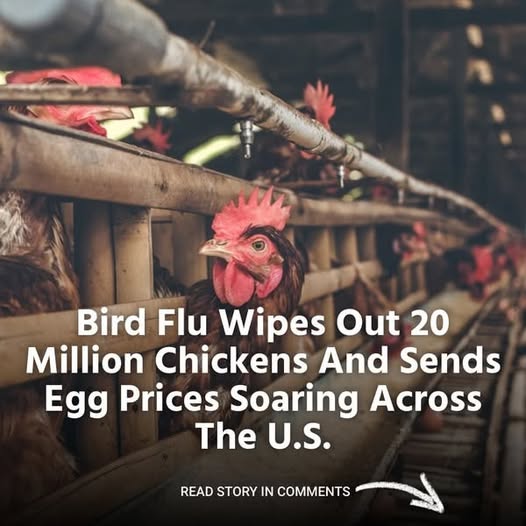The price of eggs across the United States has surged dramatically due to a severe outbreak of avian flu, a crisis that has already resulted in the culling of over 20 million egg-laying chickens. This devastating event has not only disrupted the nation’s egg supply but has also highlighted the vulnerability of the entire poultry industry.

When a disease outbreak can send prices soaring overnight, it raises important questions about the stability of food production systems. The current situation has left both consumers and industry experts wondering how such a massive disruption could happen so quickly and why the effects are so severe.
The Devastating Impact of Bird Flu
The avian flu outbreak sweeping through U.S. poultry farms has reached alarming levels. The disease, known as highly pathogenic avian influenza (HPAI), spreads rapidly among birds, often leading to severe illness and high mortality rates. Once detected in a flock, standard protocol requires that all birds in the affected area be culled to prevent further spread.
According to the U.S. Department of Agriculture (USDA), more than 20 million egg-laying chickens have already been eliminated due to the outbreak. This massive loss has led to a significant drop in egg production, which in turn has driven up prices nationwide.
The impact of the outbreak is being felt at grocery stores, where consumers are now paying much more for a staple that was once considered an affordable source of protein. The situation has also placed added pressure on farmers, many of whom are struggling to recover from the financial and operational setbacks caused by the outbreak.
Why Are Egg Prices So Sensitive?
The sudden increase in egg prices following the outbreak underscores just how fragile the poultry supply chain can be. Unlike other agricultural products, eggs are produced on a continuous cycle, and disruptions can have immediate and widespread effects.
In a normal market, the balance between supply and demand keeps prices relatively stable. However, when a disease outbreak wipes out millions of egg-laying hens, supply drops sharply while demand remains constant. This imbalance leads to a spike in prices, which can take months or even years to stabilize.
Another factor contributing to rising egg prices is the cost of replacing lost flocks. When poultry farms experience an outbreak, they must go through extensive decontamination procedures before they can introduce new birds. This process can take weeks or months, further delaying production and keeping prices elevated.
Additionally, the poultry industry operates on thin profit margins, meaning that any disruption—whether from disease, supply chain issues, or increased feed costs—can have an outsized impact on retail prices.
Consumer Reactions and Market Adjustments
For many consumers, the rapid increase in egg prices has come as a shock. Just a year ago, egg prices had stabilized after a previous avian flu outbreak, but this latest wave has sent costs soaring once again.
Some households have responded by cutting back on egg consumption or seeking alternative protein sources. Others have turned to local farms and farmers’ markets in search of more affordable options. However, even small-scale egg producers have been affected by the outbreak, with some reporting losses due to bird flu infections in their flocks.
Meanwhile, food businesses that rely heavily on eggs, such as bakeries and restaurants, are struggling to manage rising costs. Some have been forced to raise prices or find creative ways to reduce egg usage in their recipes.
The Role of the USDA and Ongoing Efforts
The USDA has been actively monitoring the situation and working to contain the outbreak. Officials have emphasized the importance of biosecurity measures, urging poultry farmers to implement strict protocols to prevent the spread of the disease.
Despite these efforts, controlling avian flu remains a major challenge. The virus is primarily spread through wild birds, making it difficult to prevent outbreaks entirely. Once an infection is detected, culling infected flocks remains the most effective way to stop further transmission.
Looking ahead, experts warn that egg prices may remain high for some time. It could take months for poultry farms to rebuild their flocks and restore production levels to normal. In the meantime, consumers should prepare for continued price fluctuations and potential supply shortages.
A System Under Pressure
The bird flu outbreak has exposed just how vulnerable the U.S. egg supply chain is to disruptions. While food production in the U.S. is generally reliable, this crisis has shown that even a single outbreak can send shockwaves through the market.
As the poultry industry works to recover, policymakers and agricultural experts may need to reconsider strategies for preventing future outbreaks. Potential solutions could include improved vaccine development, better biosecurity measures, and stronger support systems for affected farmers.
In the short term, consumers will have to navigate rising egg prices and adapt to the ongoing challenges in the market. However, the bigger question remains: how can the U.S. create a more resilient food supply system that can withstand shocks like this in the future?
For now, one thing is clear—when it comes to food security, even a single disease outbreak can have far-reaching consequences. And as long as bird flu continues to pose a threat, egg prices will likely remain volatile, leaving both consumers and farmers bracing for the next wave of uncertainty.





